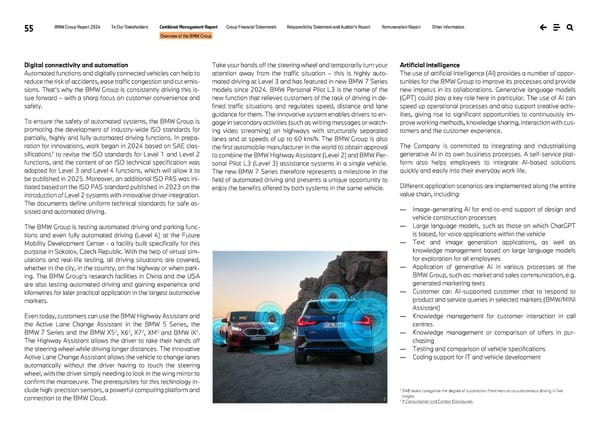55 BMW Group Report 2024 To Our Stakeholders Combined Management Report Group Financial Statements Responsibility Statement and Auditor’s Report Remuneration Report Other Information Overview of the BMW Group Digital connectivity and automation Automated functions and digitally connected vehicles can help to reduce the risk of accidents, ease traffic congestion and cut emis- sions. That’s why the BMW Group is consistently driving this is- sue forward – with a sharp focus on customer convenience and safety. To ensure the safety of automated systems, the BMW Group is promoting the development of industry-wide ISO standards for partially, highly and fully automated driving functions. In prepa- ration for innovations, work began in 2024 based on SAE clas- sifications1 to revise the ISO standards for Level 1 and Level 2 functions, and the content of an ISO technical specification was adopted for Level 3 and Level 4 functions, which will allow it to be published in 2025. Moreover, an additional ISO PAS was ini- tiated based on the ISO PAS standard published in 2023 on the introduction of Level 2 systems with innovative driver integration. The documents define uniform technical standards for safe as- sisted and automated driving. The BMW Group is testing automated driving and parking func- tions and even fully automated driving (Level 4) at the Future Mobility Development Center - a facility built specifically for this purpose in Sokolov, Czech Republic. With the help of virtual sim- ulations and real-life testing, all driving situations are covered, whether in the city, in the country, on the highway or when park- ing. The BMW Group’s research facilities in China and the USA are also testing automated driving and gaining experience and kilometres for later practical application in the largest automotive markets. Even today, customers can use the BMW Highway Assistant and the Active Lane Change Assistant in the BMW 5 Series, the BMW 7 Series and the BMW X52, X62, X72, XM2 and BMW iX2. The Highway Assistant allows the driver to take their hands off the steering wheel while driving longer distances. The innovative Active Lane Change Assistant allows the vehicle to change lanes automatically without the driver having to touch the steering wheel, with the driver simply needing to look in the wing mirror to confirm the manoeuvre. The prerequisites for this technology in- clude high-precision sensors, a powerful computing platform and connection to the BMW Cloud. Take your hands off the steering wheel and temporarily turn your attention away from the traffic situation – this is highly auto- mated driving at Level 3 and has featured in new BMW 7 Series models since 2024. BMW Personal Pilot L3 is the name of the new function that relieves customers of the task of driving in de- fined traffic situations and regulates speed, distance and lane guidance for them. The innovative system enables drivers to en- gage in secondary activities (such as writing messages or watch- ing video streaming) on highways with structurally separated lanes and at speeds of up to 60 km/h. The BMW Group is also the first automobile manufacturer in the world to obtain approval to combine the BMW Highway Assistant (Level 2) and BMW Per- sonal Pilot L3 (Level 3) assistance systems in a single vehicle. The new BMW 7 Series therefore represents a milestone in the field of automated driving and presents a unique opportunity to enjoy the benefits offered by both systems in the same vehicle. Artificial intelligence The use of artificial intelligence (AI) provides a number of oppor- tunities for the BMW Group to improve its processes and provide new impetus in its collaborations. Generative language models (GPT) could play a key role here in particular. The use of AI can speed up operational processes and also support creative activ- ities, giving rise to significant opportunities to continuously im- prove working methods, knowledge sharing, interaction with cus- tomers and the customer experience. The Company is committed to integrating and industrialising generative AI in its own business processes. A self-service plat- form also helps employees to integrate AI-based solutions quickly and easily into their everyday work life. Different application scenarios are implemented along the entire value chain, including: — Image-generating AI for end-to-end support of design and vehicle construction processes — Large language models, such as those on which ChatGPT is based, for voice applications within the vehicle — Text and image generation applications, as well as knowledge management based on large language models for exploration for all employees — Application of generative AI in various processes at the BMW Group, such as: market and sales communication, e.g. generated marketing texts — Customer car: AI-supported customer chat to respond to product and service queries in selected markets (BMW/MINI Assistant) — Knowledge management for customer interaction in call centres — Knowledge management or comparison of offers in pur- chasing — Testing and comparison of vehicle specifications — Coding support for IT and vehicle development 1 SAE levels categorise the degree of automation from manual to autonomous driving in five stages. 2 ↗ Consumption and Carbon Disclosures. 2
 BMW Group Report 2024 Page 54 Page 56
BMW Group Report 2024 Page 54 Page 56